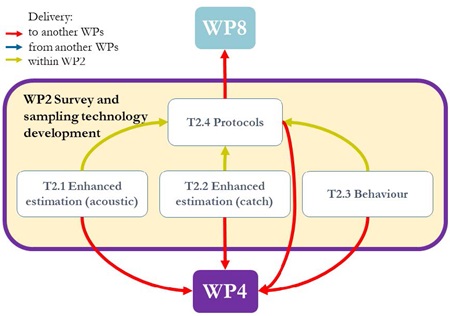Overview of tasks in work package 2
The work will combine newly available broadband acoustic sensing methods on submerged platforms with newly developed macrozooplankton and micronekton trawls, in-trawl optical species identification and measurement, and improved opening-closing codend systems. Combined, these will provide improved acoustic and trawl methodologies and protocols for accurate abundance estimates of biological resources in the mesopelagic zone.

Flows of information and data to, from and within work package 2.
Task 2.1 Implementation of acoustical and optical methods for enhanced identification and biomass estimation of mesopelagic species
Lead: Institute of Marine Research
Enhanced identification will be achieved through the use of broadband echosounders operating from 15 to 450 kHz.The marked variety in the broadband backscattering characteristics of mesopelagic organisms (especially resonance) will be used to identify characteristic properties that will be used for partitioning backscatter (Stanton et. al. 2010, see bottom of page). The very high range resolution (up to 3.3 mm from our equipment) of broadband pulses will be used to image closelyspaced individuals in order to obtain highly detailed information on the fine-scale spatial distribution and interaction of mesopelagic organisms.
Target strength estimates are lacking for many mesopelagic organisms despite being crucial to acoustic biomass estimation. We will implement an acoustic/optical system to be mounted on the headline of trawls and use it to obtain visually-verified broadband target strength estimates of mesopelagic organisms. These will be used to enhance the accuracy of biomass estimates and to provide data to advance frequency-response- and model-inversion-based acoustic target identification.
Towed vehicles with broadband echosounders (35 to 450 kHz) will be operated down to 1000 m in the MEESO sampling program. High-frequency (#100 kHz) acoustic imaging of deep mesopelagic layers will be demonstrated by multiple partners using submersible and/or towed platforms. These will be combined with ship-mounted acoustic measurements to quantify the spatial and temporal variability of mesopelagic biomass, including characteristic spatial scales of variation (related to patchiness on different spatial scales) using Fourier analyses and other statistical techniques. These empirical results will support the modelling in the project (work package 4, work package 5 and Task 2.4) by translating behaviour to spatially explicit probability distributions of biomass.
Both small and large scale horizontal variability of mesopelagic organism density are important drivers of survey strategies. Tools and methodology to assess and react to this will be demonstrated, and recommendations for mapping (work package 4) and transmission of results to commercial trawl development (work package 3) will be established.
Task 2.2 Implementation of improved catch and optical methods for enhanced biomass estimation of mesopelagic species
Lead: Institute of Marine Research
New pelagic sampling trawls with large openings (700 m2) and lined for their entire length with fine-mesh netting will be used to capture fish, cephalopods, crustaceans, and gelatinous organisms present in the mesopelagic zone for quantitative biomass estimation and direct comparisons with acoustic estimates. These trawls will be fitted with an intrawl camera system (Deep Vision, Rosen et. al. 2013; see bottom of page) for in-situ species identification and measurement at high spatial resolution, including direct integration with echosounder data.
Optical and acoustic observations of trawl performance and organism reaction to the trawls will be used to optimise the catching performance.
Some of the trawls will also be fitted with multiple-codend devices to capture samples from known depth intervals.
Task 2.3 Behaviour of mesopelagic species towards trawls, submersible platforms and vessels
Lead: Institute of Marine Research
The unknown bias due to the reaction of mesopelagic species to sampling and surveying tools will be addressed by using
- forward looking broadband acoustic sensors that can image and resolve organism behaviour up to 100 m in front of the sampling and surveying tools
- moored upward looking broadband acoustic sensors that can resolve the behaviour of organisms towards gears towed above the moorings
- trawl-mounted optical sensors to observe and quantify the behaviour of organisms to trawls.
Species- and species-group-specific knowledge of behavioural characteristics in relation to sampling trawls and submersible platforms (e.g., towed and autonomous) will be used to estimate avoidance and its resulting effect on observed quantities and hence biomass estimates. This task will focus on 2-3 important mesopelagic species or species groups.
Task 2.4 Development of protocols for abundance estimation of biomass and diversity in the mesopelagic zone
Lead: Fundacion AZTI – AZTI Fundazioa
Survey standardisation is required to compare and combine results from mesopelagic surveys. We will provide this via protocols for conducting mesopelagic surveys. A set of staged protocols will be developed. They will define the requirements for conforming surveys by vessels with varying equipment and capacity.
The protocol development will evaluate the addition of mesopelagic methodologies to existing surveys of pelagic fish resources, to provide mesopelagic estimates with little additional survey effort. Institute if Marine Research co-chaired the 2019 ICES workshop on the development of practical survey methods for measurements and monitoring in the mesopelagic zone (WKMESOMeth), which will form the starting point for the more comprehensive protocols that will be developed in this task.
The protocols will have a lasting output, extending beyond the duration of the project and will form the core of an e-learning course.
References
Rosen, S., Jörgensen, T., Hammersland-White, D., and Holst, J. C. 2013. DeepVision: a stereo camera system provides highly accurate counts and lengths of fish passing inside a trawl. Canadian Journal of Fisheries and Aquatic Sciences, 70: 1456–1467.
Stanton, T. K., Chu, D., Jech, J. M., and Irish, J. D. 2010. New broadband methods for resonance classification and high-resolution imagery of fish with swimbladders using a modified commercial broadband echosounder. ICES Journal of Marine Science, 67: 365–378.